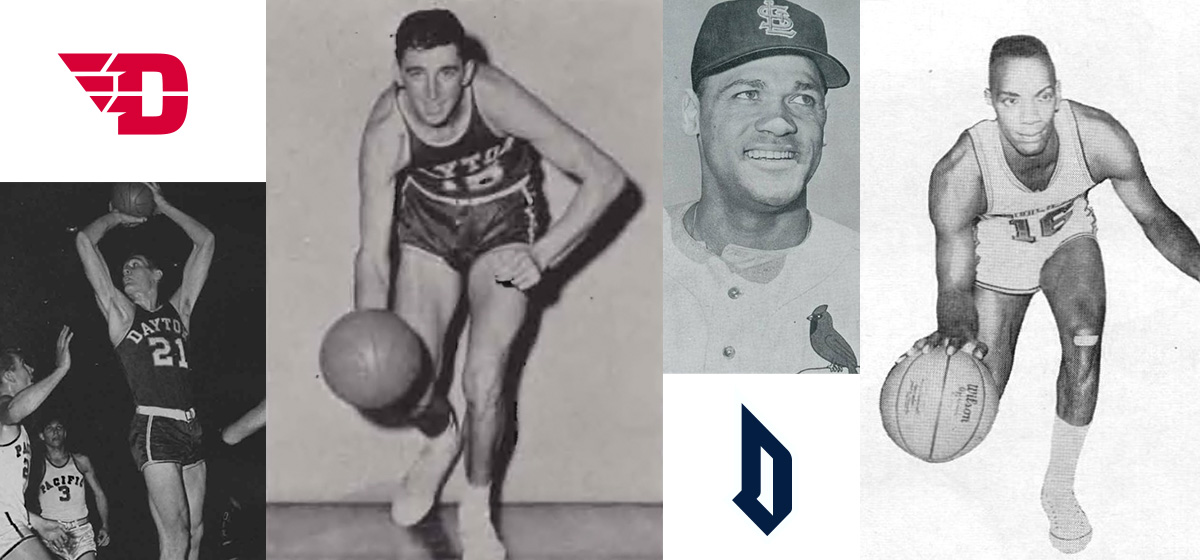Duquesne’s First Great Rivalry: Slaying Dayton’s Goliath

There have been outstanding college basketball teams and great players in Pittsburgh’s sports history, but only the 1954–55 Duquesne Dukes, led by All-Americans Dick Ricketts and Si Green, won a major national basketball tournament when they defeated a powerful Dayton Flyers team in the 1955 National Invitation Tournament. At that time, the NIT was considered more prestigious than the NCAA tournament.
Destined to meet four times, Duquesne and Dayton were ranked in the top ten when college basketball began its 1954–1955 season. They met for the first time at Madison Square Garden in the semi-final game of the ECAC Holiday Festival Tournament, played home and away games in the regular season, and met again at Madison Square Garden in the NIT final.
With Si Green out with appendicitis, Duquesne suffered an early-season loss to George Washington in the Steel Bowl final before heading to New York after Christmas for the Holiday Festival Tournament. The Dukes won their opening game against Villanova, then soundly defeated Dayton 90-75 in the semi-final. Despite Dick Rickets suffering an ankle injury in the championship game, they hung on for a 67-65 victory in the tournament final over defending NCAA national champion La Salle, led by All-American Tom Gola.
Ranked second in the nation after winning the Holiday Festival Tournament, Duquesne traveled to nearby Loretto, Pa. to resume their regular season schedule against St. Francis, a team they had handily defeated in an earlier game played in Pittsburgh. With Dick Ricketts hobbled with the ankle injury he suffered against La Salle, the Dukes were upset, 82-72, by St. Francis and Westinghouse High School graduate Maurice Stokes, who would go on to an All-American season and NIT glory.
Duquesne’s next opponent when they returned home was the revenge-minded Dayton Flyers, who were undefeated until they lost to the Dukes in the Holiday Festival Tournament, then lost in the consolation game to UCLA. The problem for Duquesne going into the game, beyond the nagging ankle injury to Dick Rickets, was Dayton’s height advantage against the much smaller Dukes.
Dayton’s front court included 7’0” center Bill Uhl, known since his high school days in Greenfield, Ohio as the “Greenfield Goliath,” and 6’8” John Horan. Duquesne, after losing its center Jim Tucker to graduation, had no player taller than Dick Ricketts at 6’7.” They relied heavily on Si Green and his magic knee-high “jumping” socks for rebounding, but Green was only 6’2.” With Dave Ricketts, Dick’s brother, and Mickey Winograd at 6’2” and Jimmy Fallon at 5’11”, the Dukes’ starting five had the look of a forward and four guards when they took the floor.
Duquesne managed to hold its own against Dayton and its height advantage, but suffered a heart-breaking 68-67 loss, their second in a row. With a healthy Dick Ricketts, they bounced back to go a winning streak, including home and away wins against nationally ranked Villanova and Cincinnati, until they traveled to Dayton for their next to the last game of the season.
After their thrilling road victory against Duquesne, the Flyers, went on their own winning tear, losing only one game, that against rival Cincinnati, before hosting Duquesne. In front of roaring home crowd, the Flyers, led by Uhl and Horan, out rebounded the undersized Dukes in a 67-58 victory. It was Duquesne’s second loss to Dayton in a season where they lost only four games.
Duquesne would have one more chance to play Dayton, when both schools turned down offers from the NCAA tournament to play in the NIT. While the Flyers had defeated the Dukes in two of their three meetings during the 1954–55 season, Duquesne was named the top seed in the tournament and Dayton, the second seed. After an outstanding season, including an upset victory over Duquesne, St. Francis was also invited to the NIT and, behind the brilliant play of Maurice Stokes, would become the tournament’s Cinderella team.
After a first-round bye, Duquesne defeated Louisville, 74-66, in the quarterfinals. In the semi-finals they won 65-61, against nationally ranked Cincinnati, led by Pittsburgh native and Central Catholic graduate Jack Twyman. Dayton easily won its quarterfinal game against St. Louis, 97-81, but in the semi-finals, faced a red-hot St. Francis team that had advanced by defeating Seton Hall and Holy Cross.
Led by Maurice Stokes 43 points in a performance that the New York Times called one of the “most dazzling” in NIT history, St. Francis battled Dayton into overtime before losing 79-73. The narrow victory advanced the Flyers to the anticipated final against Duquesne. Stokes would be named the tournament’s Most Valuable Player.
In the NIT final, Dayton hoped to contain Si Green and Dick Ricketts and, with its height advantage, control the boards, but Green and Ricketts would dominate the game, especially in the first half, when, remarkably, they combined to score all of Duquesne’s 35 first half points to give the Dukes a 35-30 lead. In the second half Rickets and Green continued their domination of the Flyers. While Bill Uhl, with 25 points, and John Horan combined for 45 points, Green, with 33 points, and Ricketts combined for 56 points in leading the Dukes to a 70-58 victory and the NIT championship.
When the Dukes flew back to Pittsburgh on Sunday, they were greeted at the Greater Pittsburgh Airport by over 5,000 cheering fans. Many of them joined a horn-honking motorcade that took the players and coach Dudey Moore from the airport through Downtown streets to another cheering throng waiting for them on the Bluff.
The next day, school officials held a rally on the Duquesne campus and a celebration later that day at South Park. While Dick Ricketts missed the events because he had to travel to Kansas City for the East-West All Star Game, Si Green was at the celebrations and told adoring fans: “This is wonderful. I never expected anything like it.”
Ricketts and Green would go on to make basketball history when they became the first two players from the same college to be the top pick in the NBA draft in consecutive years. Ricketts was drafted number one by the Milwaukee Hawks in the 1955 draft. The Rochester Royals made Si Green the number one pick, just ahead of Bill Russell, in the 1956 draft.
Dick Ricketts ended up playing his first year of professional basketball in St. Louis when the Hawks left Milwaukee before the 1955–56 season. A few years later, he also played professional baseball in St. Louis. After signing a contract in 1955 with the Cardinals and spending four seasons in the minors, he pitched for St. Louis in 1959, going 1-6 in his only season in the major leagues.
Dick Rickett’s brother Dave was a starting guard on Duquesne’s 1955 championship team, while only a sophomore. In 1957, he, too, signed a professional baseball contract with the St. Louis Cardinals. He made his debut with the Cardinals in 1963 and spent several seasons in St. Louis, mainly as a back-up catcher, before being traded to the Pirates in 1970. He was the bullpen coach for the Pirates when they won the World Series in 1971.
Maurice Stokes, after his brilliant performance in the NIT was the second player, behind Dick Ricketts, selected in the 1955 NBA draft. In 1958, Stokes, Dick Ricketts, and Jack Twyman were teammates on a Royals team that had recently moved from Rochester to Cincinnati. In the last regular game of the season, Stokes, now a rising NBA star, crashed to the floor and banged his head so severely that he became paralyzed from the neck down. Ricketts was so shaken by Stokes’ injury that he retired from professional basketball.
In one of the most inspirational stories in sports history, Jack Twyman took over Maurice Stokes’ guardianship and raised the money to cover medical bills. Stokes never gave in to his paralysis, and, through vigorous physical therapy, recovered some feeling in his hands. Before he died in 1970 at the age of 36, he was able to appear at fund raising events. In 2004, when Maurice Stokes was inducted posthumously into the Basketball Hall of Fame, Jack Twyman accepted the award on his behalf.





